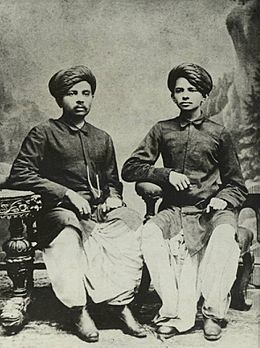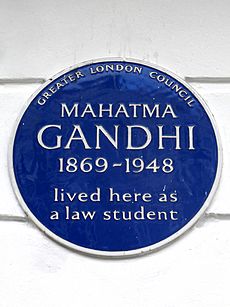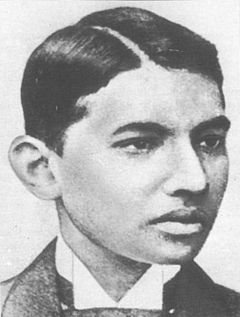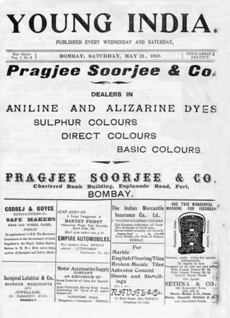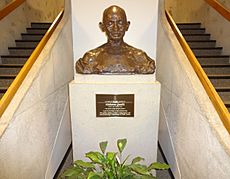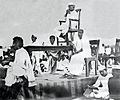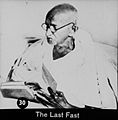Mahatma Gandhi facts for kids
Quick facts for kids
Mahātmā
Gandhi
|
|
|---|---|
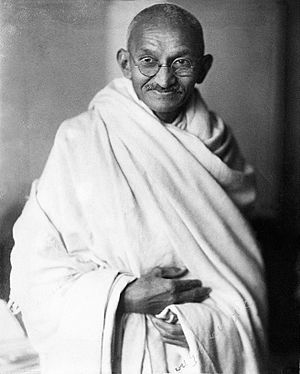
Gandhi in London, 1931
|
|
| Born |
Mohandas Karamchand Gandhi
2 October 1869 Porbandar, Porbandar State, Kathiawar Agency, British Raj
|
| Died | 30 January 1948 (aged 78) |
| Cause of death | Assassination |
| Monuments |
|
| Citizenship |
|
| Alma mater |
|
| Occupation |
|
| Years active | 1893–1948 |
| Era | British Raj |
| Known for |
|
|
Notable work
|
The Story of My Experiments with Truth |
| Political party | Indian National Congress (1920–1934) |
| Movement | Indian independence movement |
| Spouse(s) | |
| Children |
|
| Parents |
|
| Relatives | See Family of Mahatma Gandhi C. Rajagopalachari (father-in-law of Gandhi's son Devdas) |
| Awards | Time Person of the Year (1930) |
| 43rd President of the Indian National Congress | |
| In office 1924-1925 |
|
| Preceded by | Abul Kalam Azad |
| Succeeded by | Sarojini Naidu |
| Signature | |
 |
|
Mohandas Karamchand Gandhi ( GA(H)N-dee 2 October 1869 – 30 January 1948) was an Indian lawyer, anti-colonial nationalist and political ethicist. Ghandi employed nonviolent resistance to lead the successful campaign for India's independence from British rule. He inspired movements for civil rights and freedom across the world. The honorific Mahātmā (Sanskrit: "great-souled", "venerable"), first applied to him in 1914 in South Africa, is now used throughout the world.
Early years
Mohandas Karamchand Gandhi was born on 2 October 1869 into a Gujarati Hindu Modh Bania family in Porbandar, in coastal Gujarat. His father, Karamchand Uttamchand Gandhi (1822–1885), served as the dewan (chief minister) of Porbandar state. His family originated from the then village of Kutiana.
At age 9, Gandhi entered the local school in Rajkot, near his home. There, he studied the rudiments of arithmetic, history, the Gujarati language and geography. At the age of 11, he joined the High School in Rajkot, Alfred High School. He was an average student, won some prizes, but was a shy and tongue tied student, with no interest in games; his only companions were books and school lessons.
In November 1887, the 18-year-old Gandhi graduated from high school in Ahmedabad. In January 1888, he enrolled at Samaldas College in Bhavnagar State, then the sole degree-granting institution of higher education in the region. However, he dropped out, and returned to his family in Porbandar.
Mavji Dave Joshiji, a Brahmin priest and family friend, advised Gandhi and his family that he should consider law studies in London. He left for London at age 18. He trained in the law at the Inner Temple, London, and was called to the bar at age 22 in June 1891. After two uncertain years in India, where he was unable to start a successful law practice, he moved to South Africa in 1893 to represent an Indian merchant in a lawsuit.
Life in South Africa
He went on to live in South Africa for 21 years. It was here that Gandhi raised a family and first employed nonviolent resistance in a campaign for civil rights.
Immediately upon arriving in South Africa, Gandhi faced discrimination because of his skin colour and heritage, like all people of colour. He was not allowed to sit with European passengers in the stagecoach and told to sit on the floor near the driver, then beaten when he refused; elsewhere he was kicked into a gutter for daring to walk near a house, in another instance thrown off a train at Pietermaritzburg after refusing to leave the first-class. He sat in the train station, shivering all night and pondering if he should return to India or protest for his rights. He chose to protest and was allowed to board the train the next day. In another incident, the magistrate of a Durban court ordered Gandhi to remove his turban, which he refused to do. Indians were not allowed to walk on public footpaths in South Africa. Gandhi was kicked by a police officer out of the footpath onto the street without warning.
While in South Africa, Gandhi focused on the racial persecution of Indians before he started to focus on racism against Africans. By 1910, Gandhi's newspaper, Indian Opinion, was covering reports on discrimination against Africans by the colonial regime. In the years after black South Africans gained the right to vote in South Africa (1994), Gandhi was proclaimed a national hero with numerous monuments.
Political activism in India
In 1915, aged 45, Ghandi returned to India and soon set about organising peasants, farmers, and urban labourers to protest against excessive land-tax and discrimination. After he returned to India, people flocked to him because he reflected their values.
Ghandi assumed leadership of the Indian National Congress in 1921 and led nationwide campaigns for easing poverty, expanding women's rights, building religious and ethnic amity, ending untouchability, and, above all, achieving swaraj or self-rule. Gandhi wore the short dhoti woven with hand-spun yarn as a mark of identification with India's rural poor.
He began to live in a self-sufficient residential community, to eat simple food, and undertake long fasts as a means of both introspection and political protest. Gandhi led the common Indians in challenging the British-imposed salt tax with the 400 km (250 mi) Dandi Salt March in 1930 and in calling for the British to quit India in 1942. He was imprisoned many times and for many years in both South Africa and India.
Gandhi's vision of an independent India based on religious pluralism was challenged in the early 1940s by a Muslim nationalism which demanded a separate homeland for Muslims within British India. In August 1947, Britain granted independence, but the British Indian Empire was partitioned into two dominions, a Hindu-majority India and a Muslim-majority Pakistan. As many displaced Hindus, Muslims, and Sikhs made their way to their new lands, religious violence broke out, especially in the Punjab and Bengal. Gandhi visited the affected areas, attempting to alleviate distress.
In the months following, he undertook several hunger strikes to stop the religious violence. The last of these, begun in Delhi on 12 January 1948 when he was 78, also had the indirect goal of pressuring India to pay out some cash assets owed to Pakistan, which the Indian government had been resisting. Although the Government of India relented, as did the religious rioters, the belief that Gandhi had been too supportive of both Pakistan and Indian Muslims, spread among some Hindus in India. Among these was Nathuram Godse, a militant Hindu nationalist from Pune, western India, who assassinated Gandhi in Delhi on 30 January 1948.
Nonviolence

Although Gandhi was not the originator of the principle of nonviolence, he was the first to apply it in the political field on a large scale. The concept of nonviolence (ahimsa) has a long history in Indian religious thought, and is considered the highest ethical value virtue. Gandhi explains his philosophy and ideas about ahimsa as a political means in his autobiography The Story of My Experiments with Truth.
Funeral
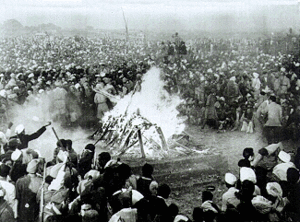
Gandhi's death was mourned nationwide. Over a million people joined the five-mile-long funeral procession that took over five hours to reach Raj Ghat from Birla house, where he was assassinated, and another million watched the procession pass by. Gandhi's body was transported on a weapons carrier, whose chassis was dismantled overnight to allow a high-floor to be installed so that people could catch a glimpse of his body. The engine of the vehicle was not used; instead four drag-ropes held by 50 people each pulled the vehicle. All Indian-owned establishments in London remained closed in mourning as thousands of people from all faiths and denominations and Indians from all over Britain converged at India House in London.
Gandhi was cremated in accordance with Hindu tradition. Gandhi's ashes were poured into urns which were sent across India for memorial services. Most of the ashes were immersed at the Sangam at Allahabad on 12 February 1948, but some were secretly taken away.
Memorials
The Birla House site where Gandhi was assassinated is now a memorial called Gandhi Smriti. The place near Yamuna river where he was cremated is the Rāj Ghāt memorial in New Delhi. A black marble platform, it bears the epigraph "Hē Rāma" (Devanagari: हे ! राम or, Hey Raam). These are widely believed to be Gandhi's last words after he was shot, though the veracity of this statement has been questioned.
Personal life
In May 1883, the 13-year-old Mohandas was married to 14-year-old Kasturbai Makhanji Kapadia (her first name was usually shortened to "Kasturba", and affectionately to "Ba") in an arranged marriage, according to the custom of the region at that time. In the process, he lost a year at school but was later allowed to make up by accelerating his studies. His wedding was a joint event, where his brother and cousin were also married. Recalling the day of their marriage, he once said, "As we didn't know much about marriage, for us it meant only wearing new clothes, eating sweets and playing with relatives." As was the prevailing tradition, the adolescent bride was to spend much time at her parents' house, and away from her husband.
In late 1885, Gandhi's father Karamchand died. Gandhi, then 16 years old, and his wife of age 17 had their first baby, who survived only a few days. The two deaths anguished Gandhi. The Gandhi couple had four more children, all sons: Harilal, born in 1888; Manilal, born in 1892; Ramdas, born in 1897; and Devdas, born in 1900.
Interesting facts about Mahatma Gandhi
- Mahātmā is not his name, but a title, meaning "great-souled", "venerable".
- As a child, Gandhi was described by his sister Raliat as "restless as mercury, either playing or roaming about. One of his favourite pastimes was twisting dogs' ears."
- The Indian classics, especially the stories of Shravana and king Harishchandra, had a great impact on Gandhi in his childhood.
- In India, Gandhi is considered the Father of the Nation and is commonly called Bapu (Gujarati endearment for 'father', 'papa').
- The Nobel Peace Prize winner Nelson Mandela is among admirers of Gandhi's efforts to fight against racism in Africa.
- Winston Churchill was a vigorous critic of Gandhi and opponent of his long-term plans. Churchill often ridiculed Gandhi.
- Ghandi was in correspondence with the Russian writer and philosopher Leo Tolstoy until Tolstoy's death in 1910 (Tolstoy's last letter was to Gandhi). The letters concern practical and theological applications of nonviolence. Gandhi saw himself a disciple of Tolstoy.
- The Mahatma Gandhi District in Houston, Texas, United States, an ethnic Indian enclave, is officially named after Gandhi.
- Indira Gandhi, an Indian politician and former Prime Minister, is not related to Mahatma Gandhi.
- Gandhi did not receive the Nobel Peace Prize, although he was nominated five times between 1937 and 1948.
Legacy
Gandhi's birthday, 2 October, is commemorated in India as Gandhi Jayanti, a national holiday, and worldwide as the International Day of Nonviolence.
Gandhi is noted as the greatest figure of the successful Indian independence movement against the British rule. He is also hailed as the greatest figure of modern India. American historian Stanley Wolpert described Gandhi as "India's greatest revolutionary nationalist leader" and the greatest Indian since the Buddha. In 1999, Gandhi was named "Asian of the century" by Asiaweek. In a 2000 BBC poll, he was voted as the greatest man of the millennium.
The word Mahatma, while often mistaken for Gandhi's given name in the West, is taken from the Sanskrit words maha (meaning Great) and atma (meaning Soul). He was publicly bestowed with the honorific title "Mahatma" in July 1914 at farewell meeting in Town Hall, Durban. Rabindranath Tagore is said to have accorded the title to Gandhi by 1915. In his autobiography, Gandhi nevertheless explains that he never valued the title, and was often pained by it.
Innumerable streets, roads and localities in India are named after Gandhi. These include M.G.Road (the main street of a number of Indian cities including Mumbai, Bangalore, Kolkata, Lucknow, Kanpur, Gangtok and Indore), Gandhi Market (near Sion, Mumbai) and Gandhinagar (the capital of the state of Gujarat, Gandhi's birthplace).
As of 2008, over 150 countries released stamps on Gandhi. In October 2019, about 87 countries including Russia, Iran, Turkey, Uzbekistan, Palestine released commemorative Gandhi stamps on 150th birth anniversary of Gandhi.
Florian asteroid 120461 Gandhi was named in his honour in September 2020. In October 2022, a statue of Gandhi was installed in Astana on the embankment of the rowing canal, opposite the cult monument to the defenders of Kazakhstan.
On 15 December 2022, the United Nations headquarters in New York unveiled the statue of Gandhi. UN Secretary-General António Guterres called Gandhi an "uncompromising advocate for peaceful co-existence".
Literary works
Gandhi was a prolific writer. His signature style was simple, precise, clear and as devoid of artificialities. One of Gandhi's earliest publications, Hind Swaraj, published in Gujarati in 1909, became "the intellectual blueprint" for India's independence movement. The book was translated into English the next year, with a copyright legend that read "No Rights Reserved". For decades he edited several newspapers including Harijan in Gujarati, in Hindi and in the English language; Indian Opinion while in South Africa and, Young India, in English, and Navajivan, a Gujarati monthly, on his return to India. Later, Navajivan was also published in Hindi. In addition, he wrote letters almost every day to individuals and newspapers.
Gandhi also wrote several books including his autobiography, The Story of My Experiments with Truth (Gujarātī "સત્યના પ્રયોગો અથવા આત્મકથા"), of which he bought the entire first edition to make sure it was reprinted. His other autobiographies included: Satyagraha in South Africa about his struggle there, Hind Swaraj or Indian Home Rule, a political pamphlet, and a paraphrase in Gujarati of John Ruskin's Unto This Last which was an early critique of political economy. This last essay can be considered his programme on economics. He also wrote extensively on vegetarianism, diet and health, religion, social reforms, etc. Gandhi usually wrote in Gujarati, though he also revised the Hindi and English translations of his books. In 1934, he wrote Songs from Prison while prisoned in Yerawada jail in Maharashtra.
Followers and international influence
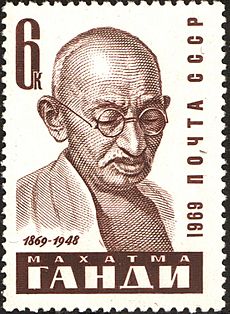
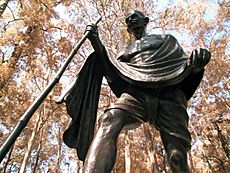
Gandhi influenced important leaders and political movements. Leaders of the civil rights movement in the United States, including Martin Luther King Jr., James Lawson, and James Bevel, drew from the writings of Gandhi in the development of their own theories about nonviolence. King said "Christ gave us the goals and Mahatma Gandhi the tactics." King sometimes referred to Gandhi as "the little brown saint."
Anti-apartheid activist and former President of South Africa, Nelson Mandela, was inspired by Gandhi.
Gandhi's life and teachings inspired many who specifically referred to Gandhi as their mentor or who dedicated their lives to spreading Gandhi's ideas. In 1931, physicist Albert Einstein exchanged letters with Gandhi, and called him "a role model for the generations to come" in a letter writing about him.
In addition, the British musician John Lennon referred to Gandhi when discussing his views on nonviolence. In 2007, former US Vice-President and environmentalist Al Gore drew upon Gandhi's idea of satyagraha in a speech on climate change.
Time magazine named The 14th Dalai Lama, Lech Wałęsa, Martin Luther King Jr., Cesar Chavez, Aung San Suu Kyi, Benigno Aquino Jr., Desmond Tutu, and Nelson Mandela as Children of Gandhi and his spiritual heirs to nonviolence.
Gandhi's ideas had a significant influence on 20th-century philosophy. Recently in the light of climate change Gandhi's views on technology are gaining importance in the fields of environmental philosophy and philosophy of technology.
Awards
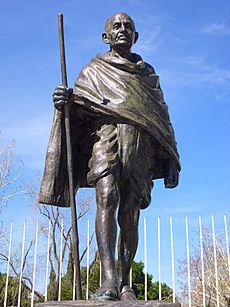
Time magazine named Gandhi the Man of the Year in 1930. In the same magazine's 1999 list of The Most Important People of the Century, Gandhi was second only to Albert Einstein, who had called Gandhi "the greatest man of our age". The University of Nagpur awarded him an LL.D. in 1937. The Government of India awarded the annual Gandhi Peace Prize to distinguished social workers, world leaders and citizens. Nelson Mandela, the leader of South Africa's struggle to eradicate racial discrimination and segregation, was a prominent non-Indian recipient. In 2011, Gandhi topped the TIME's list of top 25 political icons of all time.
When the 14th Dalai Lama was awarded the Prize in 1989, the chairman of the committee said that this was "in part a tribute to the memory of Mahatma Gandhi". In the summer of 1995, the North American Vegetarian Society inducted him posthumously into the Vegetarian Hall of Fame.
Current impact within India
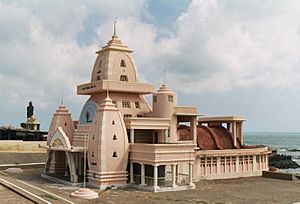
India, with its rapid economic modernisation and urbanisation, has rejected Gandhi's economics but accepted much of his politics and continues to revere his memory. Reporter Jim Yardley notes that, "modern India is hardly a Gandhian nation, if it ever was one. His vision of a village-dominated economy was shunted aside during his lifetime as rural romanticism, and his call for a national ethos of personal austerity and nonviolence has proved antithetical to the goals of an aspiring economic and military power." By contrast, Gandhi is "given full credit for India's political identity as a tolerant, secular democracy."
Gandhi's birthday, 2 October, is a national holiday in India, Gandhi Jayanti. Gandhi's image also appears on paper currency of all denominations issued by Reserve Bank of India, except for the one rupee note. Gandhi's date of death, 30 January, is commemorated as a Martyrs' Day in India.
There are three temples in India dedicated to Gandhi. One is located at Sambalpur in Odisha and the second at Nidaghatta village near Kadur in Chikmagalur district of Karnataka and the third one at Chityal in the district of Nalgonda, Telangana. The Gandhi Memorial in Kanyakumari resembles central Indian Hindu temples and the Tamukkam or Summer Palace in Madurai now houses the Mahatma Gandhi Museum.
Descendants

Gandhi's children and grandchildren live in India and other countries. Grandson Rajmohan Gandhi is a professor in Illinois and an author of Gandhi's biography titled Mohandas, while another, Tarun Gandhi, has authored several authoritative books on his grandfather. Another grandson, Kanu Ramdas Gandhi (the son of Gandhi's third son Ramdas), was found living in an old age home in Delhi despite having taught earlier in the United States.
Images for kids
-
Bronze statue of Gandhi commemorating the centenary of the incident at the Pietermaritzburg Railway Station, unveiled by Archbishop Desmond Tutu on Church Street, Pietermaritzburg, in June 1993
-
Gandhi with the stretcher-bearers of the Indian Ambulance Corps during the Boer War
-
Gandhi and his wife Kasturba (1902)
-
Gandhi with Dr. Annie Besant en route to a meeting in Madras in September 1921. Earlier, in Madurai, on 21 September 1921, Gandhi had adopted the loin-cloth for the first time as a symbol of his identification with India's poor.
-
Gandhi's first visit to Odisha in 1921, a general meeting held at the riverbed of Kathajodi
-
An admiring East End crowd gathers to witness the arrival of Mahatma Gandhi, 1931
-
Gandhi talking with Jawaharlal Nehru, his designated political heir, during the drafting of the Quit India Resolution in Bombay, August 1942
-
Gandhi in 1942, the year he launched the Quit India Movement
-
Gandhi with Muhammad Ali Jinnah in September 1944
-
Gandhi in 1947, with Louis Mountbatten, Britain's last Viceroy of India, and his wife Edwina Mountbatten
-
Gandhi with poet Rabindranath Tagore, 1940
-
"God is truth. The way to truth lies through ahimsa (nonviolence)" – Sabarmati, 13 March 1927
-
Gandhi picking salt during Salt Satyagraha to defy colonial law giving salt collection monopoly to the British. His satyagraha attracted vast numbers of Indian men and women.
See also
 In Spanish: Mahatma Gandhi para niños
In Spanish: Mahatma Gandhi para niños


